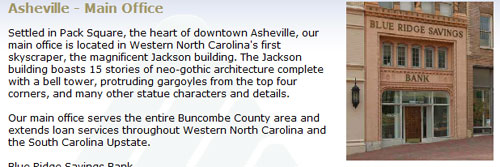Blue Ridge Savings Bank, founded in 1978, was closed today by the North Carolina Office of Commissioner of Banks, which appointed the FDIC as receiver. The FDIC sold the failed bank to Bank of North Carolina, Thomasville, NC, which will assume all deposits of Blue Ridge Savings.
All ten branches of Blue Ridge will reopen on Monday as branches of Bank of North Carolina. Depositors of Blue Ridge will have access to their money over the weekend through the use of ATM, debit cards and checks. All insured deposits of Blue Ridge will continue to be fully covered by the FDIC Deposit Insurance Fund.
Blue Ridge promoted a brand identity that offered “creative, flexible and personalized service.” The Bank’s strategy was to grow by expanding into new markets rather than through mergers or acquisitions. According to the Bank’s website, Blue Ridge began as a small hometown bank.
In August 1978, a group of more than 50 stockholders opened Blue Ridge Savings and Loan on Smoky Park Highway, the present location of the West Asheville Branch office. These stockholders were a diverse group of local business owners, merchants, farmers, developers, and others who took pride in encouraging savings by offering 6% interest on regular savings accounts. They also were among the first in this region to offer 30/60/90 day CDs. Only savings accounts and CDs were originally offered and, until the early 1990s, only mortgage loans were made.
By year-end 2008, Blue Ridge Savings Bank boasted assets of more than $300 million.
Many of those assets (loans) that Blue Ridge boasted of soon began to default en masse when real estate values cratered. By the middle of this year, Blue Ridge had a huge troubled asset ratio of 672% compared to a national median of 15%. Banks almost always wind up failing once the troubled asset ratio exceeds 100% and Blue Ridge was no exception to this rule.
Blue Ridge Savings was under regulatory scrutiny since November 2008 when it was issue a Cease and Desist Order for “unsafe or unsound” banking practices.
At June 30, 2011, Blue Ridge had total assets of $161.0 million and total deposits of $158.7 million. Bank of North Carolina agreed to purchase all of failed Blue Ridge assets, subject to a loss-share transaction with the FDIC that covers $143.2 million or 88% of the asset pool covered. Typically, the FDIC loss-share agreements have been covering only 80% or less of failed bank asset acquisitions. In order to induce Bank of North Carolina to take over failed Blue Ridge, it appears that the FDIC had to offer generous loss protection on the purchase of Blue Ridge assets.
The Bank of North Carolina previously acquired two other failed banks in South Carolina and Georgia.
The loss on the closing of Blue Ridge Savings is $38.0 million. Blue Ridge becomes the nation’s 78th banking failure and the second in North Carolina

Speak Your Mind
You must be logged in to post a comment.